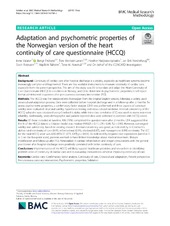| dc.contributor.author | Valaker, Irene | en_US |
| dc.contributor.author | Fridlund, Bengt Gotthard Anton | en_US |
| dc.contributor.author | Wentzel-Larsen, Tore | en_US |
| dc.contributor.author | Hadjistaropoulos, Heather | en_US |
| dc.contributor.author | Nordrehaug, Jan Erik | en_US |
| dc.contributor.author | Rotevatn, Svein | en_US |
| dc.contributor.author | Råholm, Maj-Britt | en_US |
| dc.contributor.author | Norekvål, Tone M. | en_US |
| dc.date.accessioned | 2019-09-03T09:06:01Z | |
| dc.date.available | 2019-09-03T09:06:01Z | |
| dc.date.issued | 2019-03-18 | |
| dc.Published | Valaker I, Fridlund BGA, Wentzel-Larsen T, Hadjistaropoulos, Nordrehaug JE, Rotevatn S, Råholm M, Norekvål TM. Adaptation and psychometric properties of the Norwegian version of the heart continuity of care questionnaire (HCCQ). BMC Medical Research Methodology. 2019;19:62 | eng |
| dc.identifier.issn | 1471-2288 | |
| dc.identifier.uri | https://hdl.handle.net/1956/20795 | |
| dc.description.abstract | Background: Continuity of cardiac care after hospital discharge is a priority, especially as healthcare systems become increasingly complex and fragmented. There are few available instruments to measure continuity of cardiac care, especially from the patient perspective. The aim of this study was (1) to translate and adapt the Heart Continuity of Care Questionnaire (HCCQ) to conditions in Norway, and (2) to determine its psychometric properties in self-report format administered to patients after percutaneous coronary intervention (PCI). Methods: The HCCQ was first translated into Norwegian from the original English version, following a widely used cross-cultural adaptation process. Data were collected before hospital discharge and in a follow-up after 2 months. To assess psychometric properties, a confirmatory factor analysis (CFA) was performed and three aspects of construct validity were evaluated: structural validity, hypotheses testing and cross-cultural validation. Internal consistency of the HCCQ subscales was calculated using Cronbach’s alpha, while intra-class correlation (ICC) was used to assess test-retest reliability. Additionally, socio-demographic and patient-reported data were collected to correlate with HCCQ scores. Results: Of those included at baseline, 436 (76%) completed the questionnaires after 2 months. CFA suggested that the fit of the HCCQ data to a 3-factor model was modest (RMSEA = 0.11, CFI = 0.90, TLI = 0.90). However, convergent validity was satisfactory, based on existing research. Internal consistency was good, as indicated by its Cronbach’s alphas: total continuity of care (0.95); informational (0.93), relational (0.87), and management (0.89) continuity. The ICC for the total HCCQ score was 0.80 (95% CI [0.71, 0.87] p < 0.001). As indicated by negative care experiences (rated as 1 or 2 on the five-point scale), patients seemed to have limited knowledge about medical treatment, lifestyle modification and follow-up after PCI. Participation in cardiac rehabilitation and longer consultations with the general practitioner after hospital discharge were positively correlated with better continuity of care. Conclusions: Implementation of the HCCQ will likely support healthcare providers and researchers in identifying problem areas of continuity of cardiac care and in evaluating interventions aimed at improving continuity of care. | en_US |
| dc.language.iso | eng | eng |
| dc.publisher | BioMed Central | eng |
| dc.rights | Attribution CC BY | eng |
| dc.rights.uri | http://creativecommons.org/licenses/by/4.0/ | eng |
| dc.subject | Cardiac care | eng |
| dc.subject | Confirmatory factor analysis | eng |
| dc.subject | Continuity of care | eng |
| dc.subject | Cross-cultural adaptation | eng |
| dc.subject | Patient perspective | eng |
| dc.subject | Percutaneous coronary intervention | eng |
| dc.subject | Psychometric properties | eng |
| dc.subject | Validation | eng |
| dc.title | Adaptation and psychometric properties of the Norwegian version of the heart continuity of care questionnaire (HCCQ) | en_US |
| dc.type | Peer reviewed | |
| dc.type | Journal article | |
| dc.date.updated | 2019-05-24T08:40:21Z | |
| dc.description.version | publishedVersion | en_US |
| dc.rights.holder | Copyright The Author(s) 2019 | |
| dc.identifier.doi | https://doi.org/10.1186/s12874-019-0706-z | |
| dc.identifier.cristin | 1686189 | |
| dc.source.journal | BMC Medical Research Methodology | |

